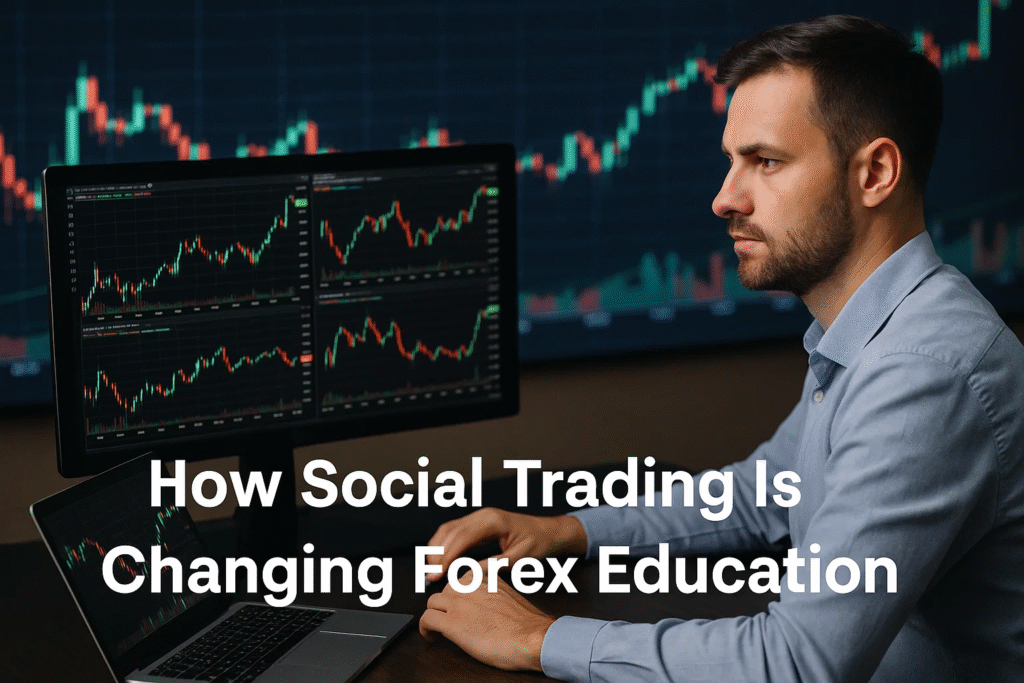
Social Trading Learning: A New Way to Trade Education
Forex education traditionally happened through books and courses. Now, the method of learning is changing. Social trading learning uses digital platforms. These platforms connect traders globally. They allow traders to share knowledge and strategies openly. This open environment changes how new traders acquire skills. It moves learning from isolated study to active, real-time collaboration.
This guide explains how social trading learning works. We discuss the benefits of peer learning in finance. We show how trading communities provide practical education. Understanding these changes is important for anyone teaching or starting forex trading. For a full look at the tools that enable this learning, see our Comprehensive Guide to Social Trading Platforms.
Peer Learning: The Core of Social Trading Education
Peer learning is the process of learning from others who are similar to you. In social trading, this means learning from other traders. This method is different from traditional teacher-student models. It focuses on shared experience and collective intelligence.
Direct Strategy Observation
Social trading platforms show what successful traders are doing. This observation is a primary form of social trading learning.
- Transparency: Platforms show the trade history of successful users. This includes entry price, exit price, and stop-loss placement.
- Actionable Examples: New traders see real strategies applied in real-time markets. They see when a profitable trader enters a trade and why. They see how the trader manages risk. This is a practical education that books cannot offer.
- Strategy Deconstruction: A learner can review a trader’s history. They can identify the patterns the trader uses. They can try to copy the logic, not just the trade. This helps develop personal strategy.
The Power of Social Investing
Social investing is often linked to copy trading platforms. Copy trading allows a user to automatically copy the trades of another person. This provides income. It also provides passive education.
- Risk Management Lessons: A learner copies a trade. They see the pro trader’s stop-loss is placed at 1% risk. The learner understands the risk rule immediately. They learn risk management by watching professional application.
- Market Exposure: By copying, the learner gains exposure to different markets or pairs. They learn about new instruments they did not know about before. This expands their market knowledge.
- Performance Review: Social trading platforms show performance statistics. The learner sees which strategies work long-term. This teaches the difference between luck and consistent skill.
Trading Communities: Real-Time Knowledge Sharing
Trading communities are digital spaces on the platforms. Traders talk to each other. They discuss market ideas, news events, and strategy performance. This real-time discussion is a huge benefit of social trading learning.
Q&A with Experienced Traders
New traders always have questions. Social platforms make asking easy.
- Instant Answers: A new trader posts a question about a technical indicator. An experienced trader answers quickly. The speed of the answer is much faster than waiting for a class or email reply.
- Contextual Help: Questions are often about a current market event. The experienced trader provides context about the current market structure. The answer is highly relevant to the present situation.
- Accessibility: Trading communities break down barriers. New traders can talk directly to people who are managing large amounts of capital. This access to successful traders motivates and informs the new trader.
Debate and Idea Validation
Peer learning thrives on debate. Traders debate ideas before taking a trade. This process helps validate or disprove a trading idea.
- Stress Testing: A trader proposes buying EUR/USD because of a pattern. Another trader disagrees. They point out a major economic events forex release coming soon. The first trader learns about the market driver they missed.
- Diverse Views: Trading communities contain people from many countries. A Japanese trader offers a perspective on the Yen. A European trader offers a view on the Euro. The new trader learns how different economies view the same currency pair.
- Reducing Bias: Talking to others helps remove confirmation bias. Confirmation bias is the tendency to only look for information that supports your existing trade idea. Peers challenge the idea, leading to better decisions.
Integrating Social Trading into Education Curricula
For Trader Education Specialists, social trading learning is a new tool. It should be integrated into formal learning programs. It provides practical context to theory.
Bridging Theory and Practice
Traditional education teaches concepts. Social trading platforms show the application of those concepts.
- Practical Example: A lesson covers support and resistance. The student then watches a top trader on a social trading platform place their stop-loss exactly at a resistance level. The theory becomes real immediately.
- Real-Time Data: Students often use delayed or simulated data. Social platforms provide real, live data releases and market action. This real exposure prepares them for the pressure of live trading.
- Contextual Memory: Learning through practical examples is easier to remember. The student remembers the successful trade by the pro trader. They remember the lesson the trade demonstrated.
Using Copy Trading Platforms for Simulation
Copy trading platforms are useful tools for practice and simulation. They allow risk-free observation.
- Demo Accounts: Most social trading platforms offer demo accounts. A new trader can copy a successful trader using a demo account. They experience the results without risking money. This builds confidence.
- Risk-Free Testing: The student can test different risk levels by copying different traders. They see how a high-risk trader and a low-risk trader perform over time. This teaches risk management visually.
- Performance Benchmarking: The student can compare their own demo trading results against the professional traders. This creates a realistic performance benchmark. It motivates the student to improve their own strategy.
The Role of Social Investing in Long-Term Skill Building
Social investing shows students that trading is a long-term process. It is not about one big win.
- Consistency: Students see the monthly returns of successful traders. They see that success is consistent, small gains, not huge, risky profits. This teaches the value of discipline.
- Drawdown Management: Students see successful traders have losing months or drawdowns. They learn that losses are a normal part of trading. They learn how professional traders handle these losses without quitting. This teaches psychological resilience.
Challenges and Best Practices for Peer Learning
While social trading learning is powerful, it has challenges. New traders must approach trading communities with caution and clear rules.
The Risk of Following Blindly
New traders often copy trades without understanding the strategy. This is a common pitfall.
- The Mistake: A new trader sees a signal and copies the trade immediately. They do not know the trader’s exit plan or risk parameters. They are unprepared when the trade goes bad.
- Best Practice: Use copy trading for learning, not just earning. Study the strategy before copying. Ask questions. Understand the logic. Do not trade what you do not understand.
Vetting Information in Trading Communities
Not all advice in trading communities is good. Some users are inexperienced or promote poor strategies.
- The Challenge: Filtering good advice from bad advice is hard for a beginner. The loudest voice is not always the smartest voice.
- Best Practice: Check the source. Look at the trader’s verified statistics. Look at their long-term performance history on the social trading platform. Only trust advice from traders with a proven, consistent track record.
Over-Trading from Social Pressure
Social interaction can lead to over-trading. Seeing other traders post profits can create pressure.
- The Effect: A trader sees a post: “Just made 50 pips on EUR/JPY!” The viewer feels they must trade immediately to catch up. They force a trade that is not part of their plan.
- Best Practice: Stick to your written trading plan. Use the community for ideas and validation, not for trade timing. Do not let peer learning become peer pressure. Your discipline is your most valuable asset.
Internal Linking Strategy: Expanding Knowledge
To fully understand the environment of social trading learning, readers should explore the technical aspects of the platforms. Learn more about the different services offered by these tools, including copy trading platforms and social investing features, by reading our primary pillar article, Comprehensive Guide to Social Trading Platforms. Furthermore, exploring the broader context of these platforms is possible by visiting our Social Trading Platforms category page. This helps reinforce the reader’s understanding of the technology behind social trading learning.
Conclusion
Social trading learning has fundamentally changed forex education. It moves away from passive reading to active, real-time peer learning. Trading communities provide constant feedback, diverse opinions, and practical examples of strategy application. This collaborative environment speeds up skill acquisition. It builds necessary trading psychology faster than isolated study.
For new traders, these social trading platforms offer a direct path to seeing professional skills in action. For educators, they offer a powerful tool to provide real-world context. Embrace social trading learning to make forex education more practical, transparent, and effective for the modern trader.
